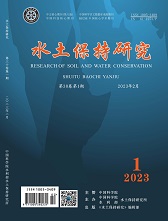[1]JIA Jun-shu,HU Wen-zhong,LI Wen-zhong,et al.Influence of Different Species Arrangement Models on Soil Anti-scourability in Converting Cropland to Forest in Beichuanhe Watershed[J].Research of Soil and Water Conservation,2006,13(03):77-79.
Copy
Influence of Different Species Arrangement Models on Soil Anti-scourability in Converting Cropland to Forest in Beichuanhe Watershed
Research of Soil and Water Conservation[ISSN 1005-3409/CN 61-1272/P] Volume:
13
Number of periods:
2006年03期
Page number:
77-79
Column:
Public date:
1900-01-01
- Title:
- Influence of Different Species Arrangement Models on Soil Anti-scourability in Converting Cropland to Forest in Beichuanhe Watershed
- Keywords:
- conversion of cropland to forest; species arrangement models; index of soil anti-scourability
- CLC:
- S157;X171.1
- DOI:
- -
- Abstract:
- The study on the influence of different species arrangement models on anti-scourability of soil was carried out in Beichuanhe watershed, datong county, Qinghai, through five models of Converting Cropland to Forest selected in low mountain areas and high mountain areas respectively.The main conclusions are as following:in low mountain areas, the index of soil anti-scourability is in evidently direct proportion to the existent masses of litter layer.The index of soil anti-scourability of model D (Hippophae rhamnoides ssp.sinensis) ranks first, up to 1.136 s/g, model E (Caragana korshinskii)is less than others, up to 0.385s/g, in different species arrangement models.In high mountain areas, the index of soil anti-scourability is in evidently direct proportion to the degree of aggregation and the total pore space.The index of soil anti-scourability of model F (Picea crassifolia) ranks first, up to 1.652 s/g, model J (Populus cathayana+Hippophae rhamnoides ssp.sinensis)is less than others in different species arrangement models.
- References:
-
[1] 大通县编纂委员会.大通县志[M].西安:陕西人民出版社, 1993.
[2] 周立华.西宁植物志[M].西宁:青海人民出版社, 1999.
[3] 中国科学院南京土壤研究所土壤物理研究室.土壤物理性质测定法[M].北京:科学出版社, 1978.
[4] 胡维银, 刘国彬, 等.黄土丘陵沟壑区小流域坡耕地土壤抗冲试验研究[J].水土保持通报, 2000, 20(3):26-28.
[5] 刘国彬, 张光辉.原状土冲刷法与人工模拟降雨法研究土壤抗冲性对比分析[J].水土保持通报, 1996, 16(2):32-37.
[6] 周佩华, 郑世清, 等.黄土高原土壤抗冲性的试验研究[J].水土保持研究, 1997, 5(4):47-66.
[7] 沈晶玉, 周心澄, 张伟华, 等.祁连山南麓植物根系改善土壤抗冲性研究[J].中国水土保持科学, 2004, 18(6):87-91.
[8] 胡建忠, 周心澄, 李文忠, 等.退耕地青海云杉人工林土壤抗冲性的试验研究[J].水土保持学报, 2004, 18(6):6-10.
[9] 胡建忠, 张伟华, 李文忠, 等.北川河流域退耕地植物群落土壤抗蚀性研究[J].土壤学报, 2004, 41(6):854-863.
[10] 胡建忠, 周心澄, 李文忠, 等.退耕地青海云杉人工林土壤抗冲性的试验研究[J].水土保持学报, 2004, 18(6):6-10.
- Similar References:
Memo
-
Last Update:
1900-01-01
